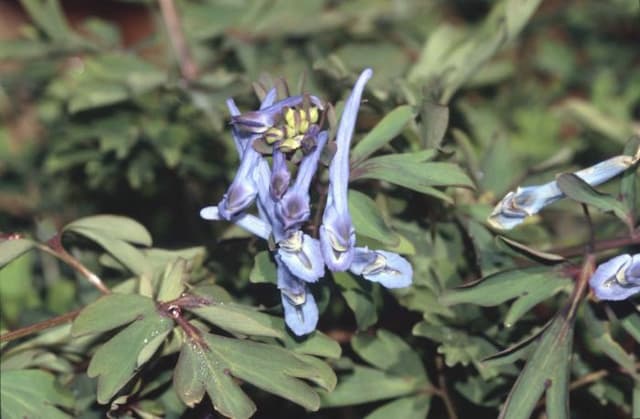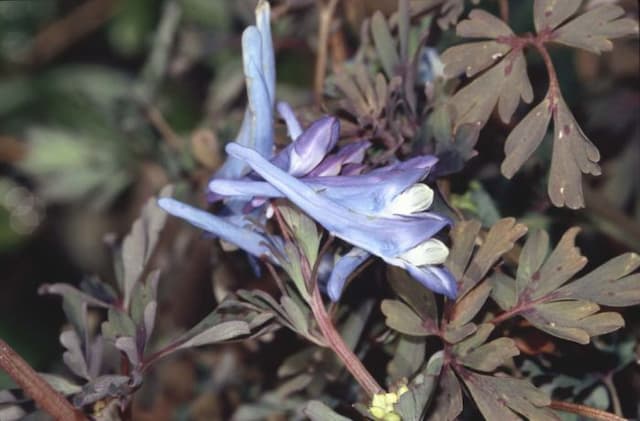Fumewort Corydalis solida subsp. incisa

ABOUT
This plant, known as Fumewort, is a perennial herb that emerges from a tuber underground. Its foliage is finely divided into numerous small segments, giving it a delicate, fern-like appearance. The leaves are usually a rich green, adding a lush look to the plant. Fumewort produces clusters of flowers in the early to mid-spring months. These flowers are often a striking shade of purple or pink, though there can be variations with hues closer to red or violet. The blooms have a distinctive shape, with a tubular, elongated spur at the back and a hooded appearance at the front, making them look somewhat like small helmets. As the flowering season wanes, the plant produces fruit that takes the form of a capsule, which contains the seeds. After seeding, the above-ground parts of the plant typically die back, with the tuber remaining dormant underground until the following spring, when the cycle begins anew. The overall impression of Fumewort in the landscape is that of an elegant and graceful plant, with its fine foliage and attractive, uniquely shaped flowers.
About this plant
 Names
NamesFamily
Papaveraceae
Synonyms
Fumewort, Incised Fumewort
Common names
Corydalis solida var. incisa, Corydalis halleri var. incisa, Capnoides incisa.
 Toxicity
ToxicityTo humans
Fumewort (Corydalis solida subsp. incisa) is considered to contain toxic alkaloids that can have harmful effects if ingested. However, the overall toxicity to humans is generally considered low, and severe poisoning is rare. If ingested in significant quantities, symptoms could potentially include nausea, vomiting, and diarrhea. In some cases, more severe symptoms such as arrhythmias, central nervous system effects, or liver and kidney impairment could occur, but detailed toxicological information specific to humans for this subspecies is limited.
To pets
Fumewort is also considered to be toxic to pets due to its alkaloid content. Symptoms of poisoning in pets could include gastrointestinal upset, such as vomiting and diarrhea, lethargy, and possibly tremors or seizures in more severe cases. As with humans, toxic ingestion of this plant could lead to arrhythmias or other organ system impairments. Pet owners should keep their animals away from this plant and seek veterinary care if ingestion is suspected.
 Characteristics
CharacteristicsLife cycle
Perennials
Foliage type
Deciduous
Color of leaves
Green
Flower color
Pink
Height
4-6 inches (10-15 cm)
Spread
4-6 inches (10-15 cm)
Plant type
Bulb
Hardiness zones
5
Native area
Europe
Benefits
 General Benefits
General Benefits- Ornamental Value: Adds aesthetic appeal to gardens with its attractive foliage and flowers.
- Attracts Pollinators: Flowers provide nectar for bees and other insects, which can help pollinate other plants in the garden.
- Erosion Control: The root system can help stabilize soil and prevent erosion in certain settings.
- Drought Tolerance: Once established, some varieties can tolerate periods of dry conditions, reducing the need for frequent watering.
- Shade Tolerance: Can thrive in shady areas where other plants may struggle to grow, thus helping in creating a diverse shade garden.
 Medical Properties
Medical Properties- Antispasmodic - Corydalis solida may reduce muscle spasms.
- Anodyne (Pain reliever) - It has been used to relieve pain, especially in the context of headaches and menstrual cramps.
- Sedative - The plant might have properties that help in inducing relaxation and assisting with sleep issues.
 Air-purifying Qualities
Air-purifying QualitiesThis plant is not specifically known for air purifying qualities.
 Other Uses
Other Uses- Corydalis, commonly known as fumewort, can be used as a natural dye for fabrics, yielding subtle coloration due to the presence of pigments in the plant’s tissue.
- Fumewort's attractive flowers make it a choice plant for ornamental purposes in gardens, especially in woodland or shaded areas where it can thrive.
- The seeds of fumewort are sometimes used as a food source for ant species; in return, the ants disperse the seeds, aiding in the plant's propagation.
- The foliage of fumewort can be included in compost piles as a green material to help maintain the necessary carbon-nitrogen balance.
- Due to its early blooming period, fumewort can be used to provide an early nectar source for bees and other pollinating insects emerging in the spring.
- In floral arrangements, fumewort may be used to add delicate texture and hints of color, especially in spring-themed compositions.
- Fumewort’s visually interesting seed pods can be collected and used for decorative purposes in dried floral crafts and arrangements.
- When crushed, the leaves of fumewort can release a strong odor that may be used as a form of natural pest repellent in gardens.
- The plant can play a role in soil stabilization and erosion control in shaded, moist areas due to its robust root system.
- In some cultures, fumewort has been traditionally used for ceremonial purposes, with its blooms symbolizing humility and modesty.
Interesting Facts
 Feng Shui
Feng ShuiCorydalis is not used in Feng Shui practice.
 Zodiac Sign Compitability
Zodiac Sign CompitabilityCorydalis is not used in astrology practice.
 Plant Symbolism
Plant Symbolism- Resilience: Corydalis solida subsp. incisa, commonly known as Fumewort, often grows in harsh environments, symbolizing the ability to overcome adversity and thrive in challenging conditions.
- Healing: Historically, Fumewort has been used for medicinal purposes, representing healing and the alleviation of pain.
- Hidden Beauty: With its delicate flowers that can be easy to overlook, Fumewort signifies the idea that beauty can be found in unexpected places.
 Water
WaterFumewort, commonly known as Corydalis solida subsp. incisa, prefers evenly moist soil, especially during its growing season in spring. It's best to water the plant when the top inch of soil feels dry to the touch, which may be about once a week, depending on environmental conditions. Typically, you should provide around half a gallon of water evenly around the plant, ensuring that the soil is moist but not waterlogged. During its dormant period in summer, water sparingly, just enough to prevent the soil from completely drying out.
 Light
LightFumewort thrives best in partial shade or dappled sunlight. The ideal spot for this plant is under the canopy of deciduous trees where it can receive filtered light. Avoid exposing it to full, direct afternoon sun, as this can be too intense and may cause the foliage to scorch.
 Temperature
TemperatureFumewort is a hardy plant that can tolerate a wide range of temperatures, but it grows best in cooler conditions. The plant can survive minimum temperatures down to about 5 degrees Fahrenheit but prefers a range of 50 to 70 degrees Fahrenheit during its active growth in spring. Avoid exposing it to extreme heat above 80 degrees Fahrenheit, as this can be detrimental to the plant.
 Pruning
PruningPruning Fumewort is generally not necessary except for removing spent flowers or damaged foliage. After flowering, trim away the faded blooms to keep the plant looking tidy and potentially encourage additional blooming. Prune any damaged leaves or stems in the spring when new growth appears to maintain plant health and aesthetics.
 Cleaning
CleaningAs needed
 Soil
SoilThe best soil mix for Fumewort should be well-drained, rich in organic matter, and moist. It thrives in slightly acidic to neutral pH, ranging from 6.0 to 7.0. A mixture incorporating leaf mold, loam, and perlite can closely match its natural woodland conditions.
 Repotting
RepottingFumewort is usually grown from tubers and does not require frequent repotting. It should be repotted every 3-4 years or when the tubers outgrow the current container.
 Humidity & Misting
Humidity & MistingFumewort prefers moderate to high humidity levels, similar to its natural woodland habitat, but it is adaptable and can tolerate lower humidity common in household environments.
 Suitable locations
Suitable locationsIndoor
Provide shade, cool temperatures, and moist soil for indoor Fumewort.
Outdoor
Plant Fumewort in dappled shade with well-draining, rich soil.
Hardiness zone
5-7 USDA
 Life cycle
Life cycleCorydalis solida subsp. incisa, commonly known as Fumewort, begins its life cycle as a small tuber underground, which sprouts in early spring, rapidly producing finely divided, fern-like leaves. From these leaves, the plant develops a flowering stalk that bears clusters of purple to pink or sometimes white flowers, blooming from April to May. After pollination, typically by insects, the flowers develop into elongated seed pods that split open to disperse small, black seeds. The plant's foliage dies back by mid-summer, and Fumewort enters a period of dormancy as the tuber rests underground. Each year, the tuber gives rise to new growth, and the plant can also spread by self-seeding if conditions are favorable. The life cycle is largely dependent on seasonal cycles, with growth in spring, seed setting in early summer, and dormancy during the harsher conditions of late summer, fall, and winter.
 Propogation
PropogationPropogation time
Spring
Corydalis solida, commonly known as Fumewort, is typically propagated by dividing its tubers. The best time for this method of propagation is in late summer to early fall, after the foliage has died back. To propagate by division, carefully dig up the clump of Fumewort when the plant is dormant. Gently separate the tubers, ensuring each section has at least one growth point or eye. Replant the divisions immediately, placing them at a depth of about 2 to 3 inches (5 to 7.5 centimeters) in the soil, and space them about 4 to 6 inches (10 to 15 centimeters) apart. The soil should be well-draining and the site should offer dappled shade, mimicking the plant's natural woodland habitat. Water well after planting to settle the soil around the tubers.









